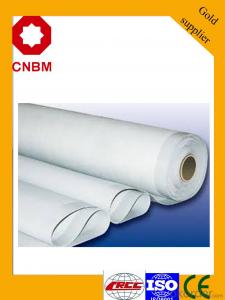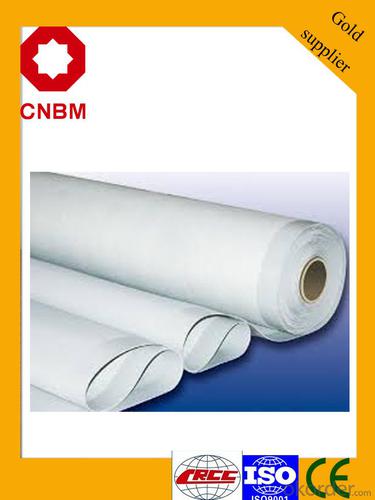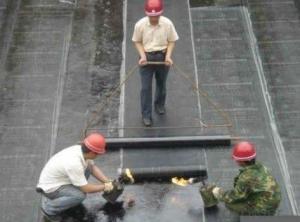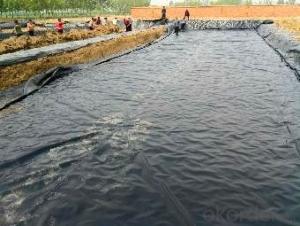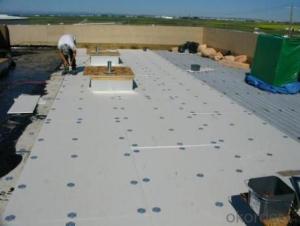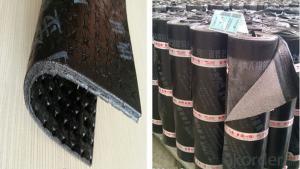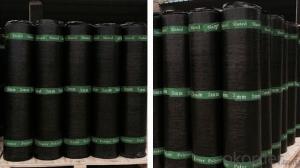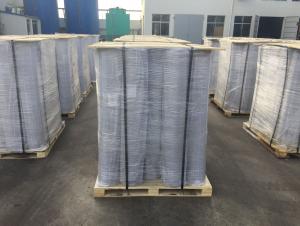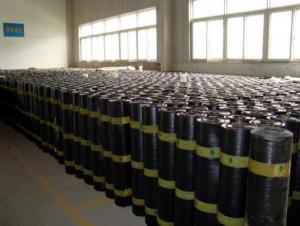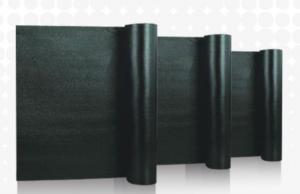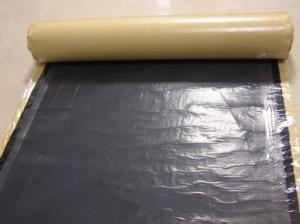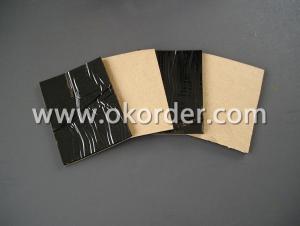Modified Bitumen Sand Surface SBS/APP Waterproof Membrane
- Loading Port:
- Shanghai
- Payment Terms:
- TT OR LC
- Min Order Qty:
- 44 roll
- Supply Capability:
- 100000 roll/month
OKorder Service Pledge
OKorder Financial Service
You Might Also Like
Product description
SBS modified bitumen waterproof membranes use high quality needle punched polyester mat or fiberglass compound mat as the base reinforcement. And use SBS modified bitumen as the dip-coat material. The SBS modified bitumen waterproof membrane are widely used for roof waterproof projects.
Specifications
1. Width: 125px-1m or as customized
2. Length: 3m/5m/10m/15m/20m or as customized
3. Thickness: 2mm/3mm/4mm/5mm
4. Surface: PE film, Colorful Sand, Mineral Granules or Aluminium foil
Technical Parameters
No. | Item | Index | |||||
I | II | ||||||
PY | G | PY | G | PYG | |||
1 | Solvend content(g/m²)≥ | 3mm | 2100 | - | |||
4mm | 2900 | - | |||||
5mm | 3500 | ||||||
Experiment phenomena | - | Carrier non-ignitable | - | Carrier non-ignitable | - | ||
2 | Heat risistance | °c | 90 | 105 | |||
≤mm | 2 | ||||||
Experiment phenomena | Non flow,dippage | ||||||
3 | Cold bending/°c | -20 | -25 | ||||
No crack | |||||||
4 | Waterproof 30min | 0.3MPa | 0.2MPa | 0.3MPa | |||
5 | Tensile strength | Maximum peak tensile(N/50mm)≥ | 500 | 350 | 800 | 500 | 900 |
Inferior peak tensile (N/50mm)≥ | - | - | - | - | 800 | ||
Experiment phenomena | In stretching process,the test specimen has no asphalt cracks or separate with the carrier | ||||||
6 | Elongation | Maximum peak elongation | 30 | - | 40 | - | - |
Inferior peak elongation | - | - | 15 | ||||
Product Feature
1. SBS modified bitumen waterproof membrane has good watertightness.
2. SBS modified bitumen waterproof membrane is high strength of extension, good ductility
3. SBS modified bitumen waterproof membrane is special used for low temperature.
4. SBS modified bitumen waterproof membrane is easy construction, can be constructed all of the year by the way of hot melt.
Application
1.Make sure the roof deck is smooth,clean and dry(Moisture<9%),then apply the surface of roof deck with a kind bitumen paint till dry.
2. There are two methods in application:
One way is by heating and melting method---Heat the membrane and roof deck surface by heating and melting method to be nearly melted(not flowing),then install the membrane fully bonded to the roof deck with overlaps of 5-250px.
The other way is by cold adhesive method---Pour the cold adhesive on the roof deck then roll the membrane to install it to be fully sticked to roof deck.
By heating and melting method and by cold adhesive can be used in alternation as requested.
3.After application,, a full serious inspection is required,that’s to make sure no air bubble,,no fold,,no falling away etc. and guarantee the waterproof life.
Requirements for construction
1.The base should be dry and clean. Do not work in the rainy or snowy day.
2.Do not work under heavy wind(above 5 grade)
3.Unsuitable for construction below 5°C
4.If it is rain or snow in the process of construction, protective measure to the laid membrane is must.
5.All the workers should put on special uniforms to keep safe when installing. There should be equipments for fire controls.
product show
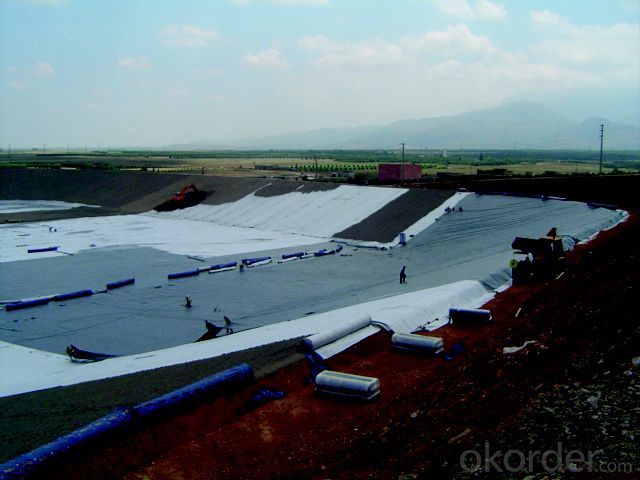
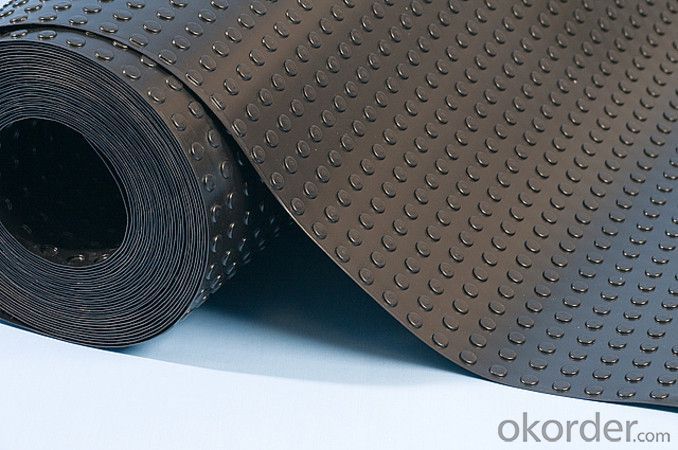
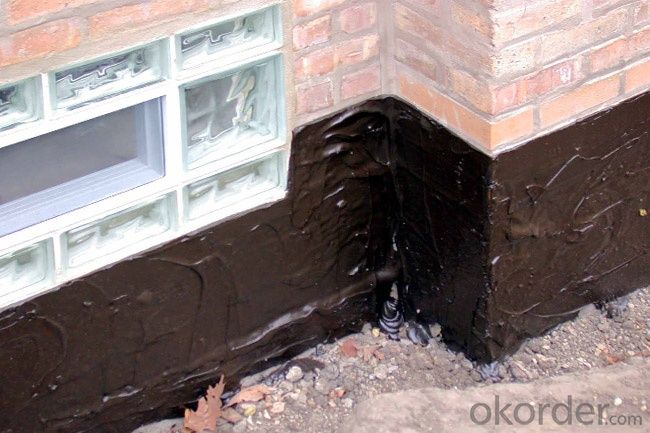
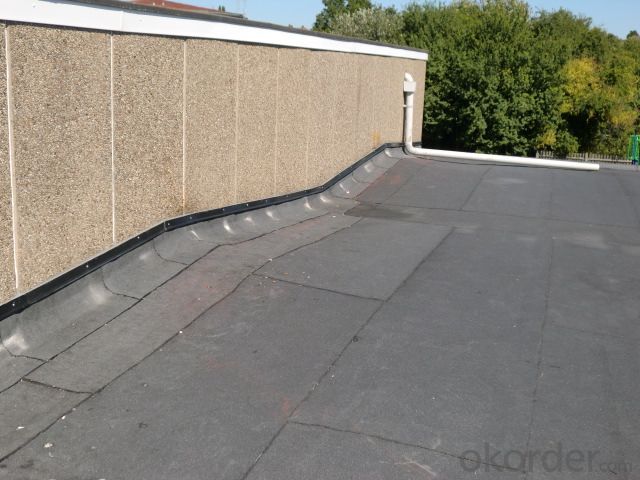
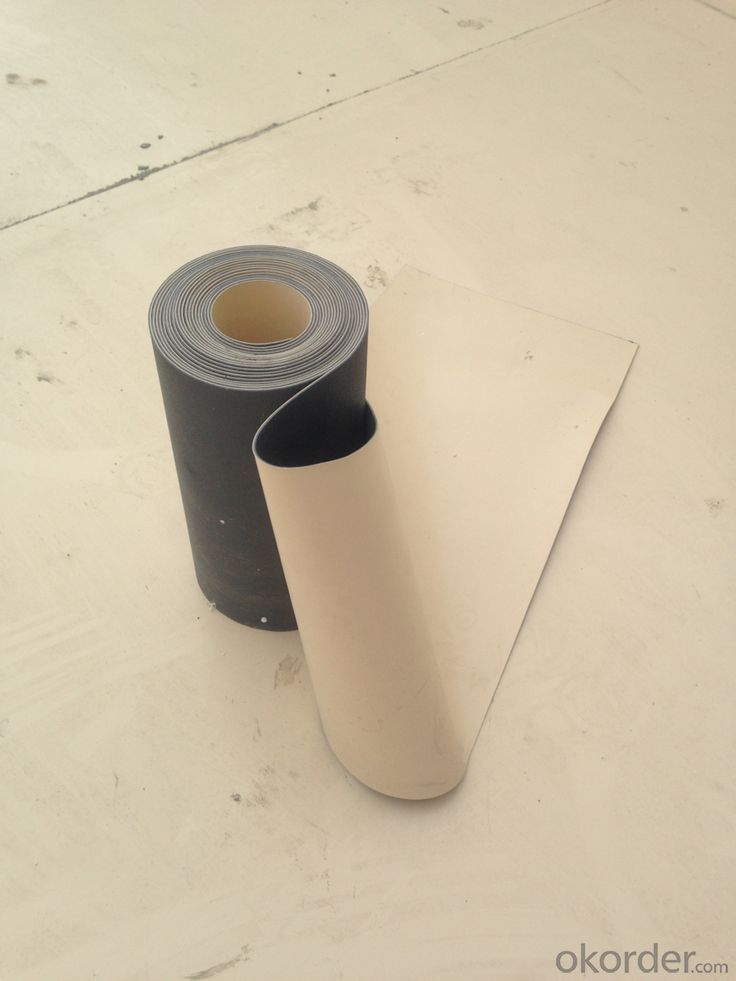
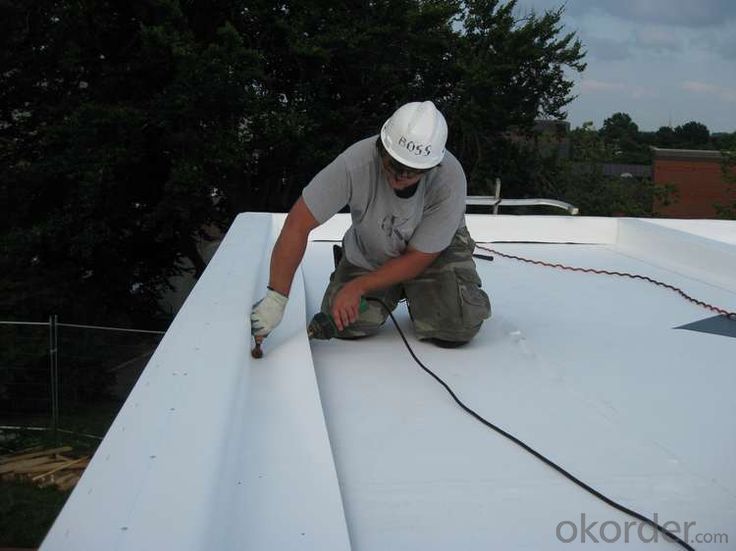
FAQ
Q: What's the delivery time ?
A: 3-5 days for 1-600 rolls, 10-15 days for container.
Q: What's the payment terms ?
A: TT/LC
Q: How do you make replacement with quality problems ?
A: New replacement will be packed into your next order or send to you directly after receive video or photo about quality problems.
- Q: Are waterproofing membranes resistant to extreme weather conditions?
- Yes, waterproofing membranes are designed to be highly resistant to extreme weather conditions. They are engineered to withstand heavy rain, snow, high winds, and temperature fluctuations without compromising their effectiveness. They provide a durable barrier against moisture, protecting structures from water damage, leaks, and potential structural issues caused by extreme weather.
- Q: Are waterproofing membranes resistant to chlorine exposure?
- Yes, waterproofing membranes are typically resistant to chlorine exposure.
- Q: Can a waterproofing membrane be used for a plaza deck waterproofing?
- Plaza deck waterproofing necessitates the use of a waterproofing membrane as they are consistently exposed to the elements, such as rain and snow. This is crucial in preventing water infiltration and potential harm to the underlying structure. Waterproofing membranes are specially designed to serve this purpose and safeguard the deck against moisture-related problems like leaks, deterioration, and mold formation. These membranes are typically constructed from materials like bitumen, PVC, or EPDM, and are applied in multiple layers to guarantee a strong and impermeable seal. By utilizing a waterproofing membrane, plaza decks can effectively preserve their structural integrity and longevity.
- Q: How long do waterproofing membranes last?
- The lifespan of waterproofing membranes can vary depending on various factors such as the type of membrane used, the quality of installation, environmental conditions, and maintenance practices. Generally, high-quality waterproofing membranes can last anywhere from 10 to 50 years. For example, bituminous membranes, which are commonly used in roofing applications, typically have a lifespan of around 20 to 30 years. On the other hand, more advanced synthetic membranes like PVC or TPO can last up to 40 years or even longer. However, it's important to note that these estimations are based on ideal conditions and regular maintenance. Factors such as exposure to extreme weather conditions, improper installation, lack of maintenance, or physical damage can significantly reduce the lifespan of the membranes. Therefore, it is crucial to consult with professionals and follow manufacturer's recommendations for maintenance to ensure the longevity of the waterproofing membranes.
- Q: Can a waterproofing membrane be used for theme parks or amusement centers?
- Absolutely, theme parks and amusement centers can certainly benefit from the use of a waterproofing membrane. These venues often feature a variety of water-focused attractions like water slides, splash pads, and swimming pools. In order to guarantee the safety and durability of these facilities, it is crucial to have a reliable waterproofing system in place. By acting as a protective barrier against water infiltration, a waterproofing membrane prevents any potential harm to the underlying structures and eliminates the risk of water leakage. This ensures that water remains confined to its designated areas, minimizing the likelihood of accidents or structural problems. Moreover, a waterproofing membrane can also be employed in walkways and outdoor seating areas, shielding them from water damage caused by rainfall or other water-related activities within the park. Overall, incorporating a waterproofing membrane into theme parks or amusement centers is a wise investment that guarantees the long-lasting functionality, safety, and resilience of the water-based attractions and other park structures.
- Q: Can waterproofing membranes be used on mechanical rooms?
- Indeed, mechanical rooms can benefit from the application of waterproofing membranes. Within these rooms, one can frequently find water-sensitive equipment like boilers, pumps, and ventilation systems. By installing waterproofing membranes, it is possible to establish a safeguarding shield against water infiltration, thus averting any leaks, moisture accumulation, or potential harm to the equipment. Moreover, these membranes also possess the ability to offer thermal insulation, noise reduction, and fire resistance attributes. Therefore, it becomes crucial to select the suitable waterproofing membrane type that aligns with the distinct necessities and prerequisites of the mechanical room.
- Q: Can a waterproofing membrane be used on tunnels with vehicular traffic?
- Yes, a waterproofing membrane can be used on tunnels with vehicular traffic. Waterproofing membranes are designed to provide a barrier against water infiltration, protecting the structure from potential damage caused by moisture. In tunnels with vehicular traffic, water can seep through the concrete and cause corrosion, deterioration, and even compromise the structural integrity of the tunnel. By applying a waterproofing membrane, it creates a protective layer that prevents water from penetrating the tunnel walls, roof, and floor. This helps to extend the lifespan of the tunnel and ensures the safety of vehicles passing through. However, it is essential to select a waterproofing membrane specifically designed for heavy traffic conditions to withstand the constant load and wear. Additionally, proper installation and regular maintenance are crucial to ensure the effectiveness and longevity of the waterproofing system in tunnels with vehicular traffic.
- Q: Can a waterproofing membrane be used on terraces or patios?
- Yes, a waterproofing membrane can be used on terraces or patios. In fact, it is highly recommended to use a waterproofing membrane in these areas to prevent water damage and leakage. Terraces and patios are exposed to various weather conditions, including rain and snow, which can lead to moisture seeping into the underlying structure. A waterproofing membrane acts as a barrier, preventing water from penetrating the surface and protecting the integrity of the terrace or patio. It helps to extend the lifespan of the structure and prevents costly repairs in the long run. Additionally, using a waterproofing membrane also helps to create a more comfortable and usable space, as it eliminates the risk of water accumulation and potential slip hazards. Overall, investing in a high-quality waterproofing membrane is a wise decision for anyone looking to protect their terrace or patio from water damage.
- Q: Are there any specific safety precautions to consider when installing a waterproofing membrane?
- Yes, there are several safety precautions to consider when installing a waterproofing membrane. Firstly, it is important to ensure that all necessary personal protective equipment (PPE) is used by the installation team. This may include gloves, safety glasses, and appropriate footwear to prevent any injuries or exposure to hazardous materials. Additionally, it is crucial to work in a well-ventilated area to avoid inhalation of fumes or vapors emitted during the installation process. If working in a confined space, proper measures should be taken to ensure adequate ventilation and the use of proper respiratory protection if necessary. Furthermore, it is important to follow the manufacturer's instructions and guidelines for the specific waterproofing membrane being installed. This includes understanding any potential hazards associated with the product, such as flammability or toxicity, and taking necessary precautions to prevent accidents or exposure. Another safety consideration is to ensure that the installation area is properly prepared before beginning the process. This may involve removing any debris, cleaning the surface, and addressing any potential hazards or obstacles that could pose a risk to the installation team. Lastly, it is important to have a designated safety plan in place, including emergency procedures and first aid kits readily available in case of accidents or injuries. Regular safety inspections and monitoring throughout the installation process are also recommended to identify and address any potential safety risks promptly. By following these safety precautions, the installation of a waterproofing membrane can be carried out safely and effectively, minimizing the risk of accidents or injuries.
- Q: Can a waterproofing membrane be installed on bathroom or shower walls?
- Yes, a waterproofing membrane can be installed on bathroom or shower walls to protect the underlying structure from water damage.
Send your message to us
Modified Bitumen Sand Surface SBS/APP Waterproof Membrane
- Loading Port:
- Shanghai
- Payment Terms:
- TT OR LC
- Min Order Qty:
- 44 roll
- Supply Capability:
- 100000 roll/month
OKorder Service Pledge
OKorder Financial Service
Similar products
Hot products
Hot Searches
Related keywords
